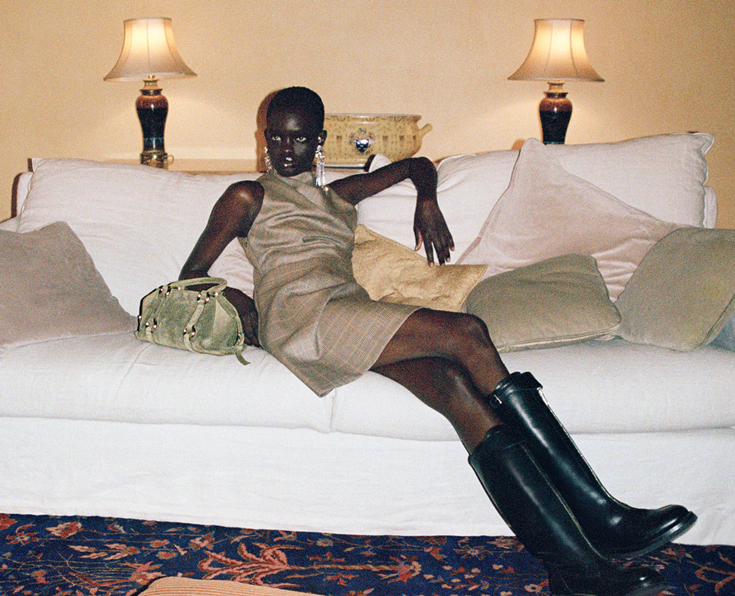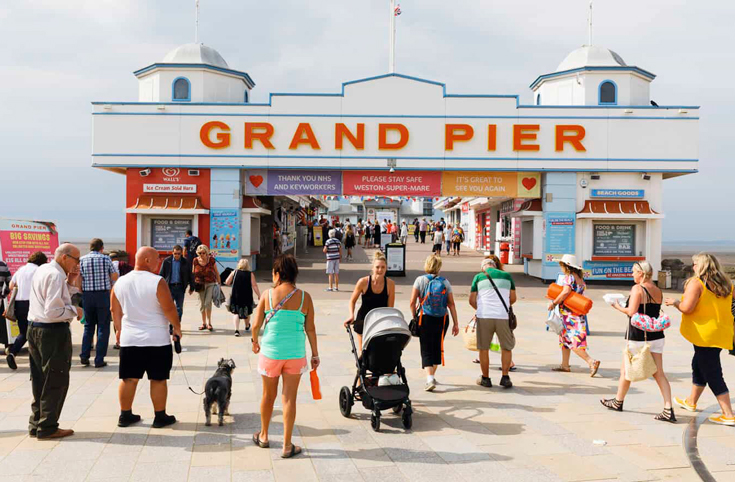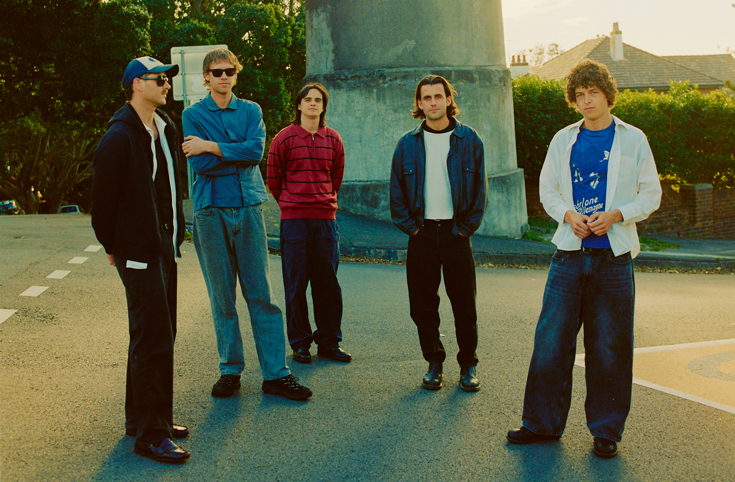STEPHEN DOIG ON SAVILE ROW IN THE 21ST CENTURY

On a crisp November morning, winter sun lights up the Palladian splendour of its buildings and their gleaming railings. As the shopfronts start to be unlocked, Savile Row is springing to life. Yes, there’s a sense of patrician uprightness to the street, but some recent additions to the historic stretch, including a smart coffee emporium and a burst of new stores opening, mean that the Row, as it’s affectionately known, is pulsing with energy.
“You feel it, walking down the street,” says the spry Edward Sexton, a living legend of the tailoring world and a custodian of arguably the most famous street in the world for sharp suits. “People used to come here to visit their tailor and that was it, but now there’s much more curiosity about what’s going on up and down the street – the Savile Row man will still be going to have a bespoke suit made, but he’ll stop and have a coffee, perhaps pick up a ready-to-wear shirt at my store and then check out some shoes a few doors down.” Savile Row is mythic, its name synonymous with a noble sense of refinement and a gentlemanly approach to proper dressing that’s almost an antiquity in today’s sportswear-centric world.
If you’ve ever had the privilege of having a suit fitted there, you’ll be familiar with the quiet majesty of the experience; a good tailor can spot things about your frame you might not even know yourself and employ their skill and wizardry to manipulate it to its best form. Churchill wrote home from Eton to request supplies of its finery. Fleming’s Bond would dress in nothing else. And every monarch since the mid-1800s, when it began to spring to life, has been dressed in not just its immaculate tailoring but its ceremonial uniforms.
Which is not to say that the Row hasn’t taken its fair share of knocks recently; after the travel, service and hospitality industries, the formalwear business was hit seismically by the pandemic. Suits had already been casualised beyond recognition thanks to the rise of sportswear – brands such as Zegna, Louis Vuitton under the late Virgil Abloh and Kim Jones at Dior reimagining tailoring for Gen Z in a looser, freer form – but the work-from-home mandates and a lack of need for proper suits for either work or pleasure had a devastating effect on the tailoring industry. Pre-pandemic, more than 60 per cent of sales on the Row came from trunk shows abroad, so when the travel industry ground to a halt so did its sales. That said, the SS23 catwalks showcased a fightback of some sort in favour of the structure and form that a serious suit can offer. At Dries Van Noten, Yves Saint Laurent, Alexander McQueen and Hermès there was a rallying cry, louder and more pronounced than any the menswear industry’s seen in years. The addition of shirts and ties – ties! Remember those? – was telling, like relics from another era. We’re seeing a shift towards structure and classicism in menswear.
All of this is good news for Savile Row because some of its most famous residents have suffered over the last couple of years. Kilgour, founded in 1882, closed its doors in March 2020, citing problems with the supply chain, and last year saw troubling reports about the future of Gieves & Hawkes, one of the oldest of all the grand old boys on the Row. Situated at the enviable address No. 1 Savile Row, its Hong Kong parent company Trinity Group, which also owns Kent & Kurwen and Hardy Amies, ran into financial problems and went into liquidation in 2021. Recently, The Pollen Estate, which owns the street, have made efforts to tempt certain houses that specialise in the more sartorial end of the menswear spectrum to the Row with reduced rents (to varying degrees of success: eyebrows were raised at the arrival of Clothsurgeon, a bespoke streetwear brand). Of course, reports of Savile Row’s end have been greatly exaggerated before. In the 20th century, the rise of cheaply made high-street suits, which could be adapted as made-to-measure to fit a buyer’s frame in-store, threatened its existence. Back then, the old guard of the tailoring institutions, which still operated (and to some extent still do) like old-school private members’ clubs and worked on a recommendation basis, had their feathers ruffled by the changing moods of the zeitgeist. The arrival of outfitting renegades in the ’60s (of which more later) and the shake-up caused by newcomers Ozwald Boateng and Richard James who – hold on to your monocles – opened on Sundays, which was thought unseemly, ripped up the rulebook of suiting with bold colours and impactful linings. Savile Row has always dealt with the changing winds of time.
“My grandfather arrived at the store in the 1940s to find it had been destroyed in a bombing the night before,” says William Skinner, managing director and fifth-generation family member of historic house Dege & Skinner, which makes the royal family’s military uniforms and made suits for David Bowie and Michael Jackson. “We started from scratch again. The Row’s great strength is tradition, but that doesn’t mean we don’t innovate.” The house, for example, started supervising fittings over Zoom, with clients measuring themselves in front of the camera, and diversified into sports jackets for a more casual era, likewise shirts. They’ve seen “a huge boom” in sales this year, thanks to weddings being back on the agenda and event dressing taking on renewed momentum. “We’ve seen a real uplift in sales since the dark times of Covid and a great deal of interest in made-to-measure suiting and shirts,” says Sexton. The tailor, who at 80 is as nimble and energetic as he ever was and can fit your suit with the forensic eye of a surgeon, first arrived on the Row in 1969 as the right-hand man to the famed Tommy Nutter, at Nutters of Savile Row. Their effect sent ripples up the street. “At that time it was like an old gentleman’s club, where you had to be invited and all the shop windows had dusty velvet curtains. We changed all that,” he says.
In those days, traditionally, a man would be “introduced” to a house, most likely by his father, but the pair slashed through the staid seams of Savile Row, opening up their doors to all. They also began to showcase innovative window displays where beforehand only a polite arrangement on a mannequin would have done. Soon, The Beatles were attired in their signature late-’60s look of exaggerated shoulders and lapels with narrow waists – three out of the four suits worn on the cover of Abbey Road were by Nutters (George Harrison opted for double denim instead). For their wedding suits, both John Lennon and Mick Jagger called on the store, which was co-financed by Cilla Black, a close friend of Nutter. Not that Sexton, who launched his own label in 1990 and shifted operations to Knightsbridge, is one for quaint nostalgia. He made the decision to come back to Savile Row two years ago and recently refurbished his store to reinvigorate and drum up enthusiasm for the area.
“Savile Row is part of British history and one of the most recognised addresses around the world. It felt right to come back,” says Sexton, who in recent years has added Naomi Campbell, Kate Moss and Harry Styles, for whom he made a bubblegum pink suit, to his roll call of clients. Not that it’s celebrity sheen which keeps him interested; it’s the cut and thrust of the tailoring business. “Yes, we’re all in competition with each other on Savile Row, but it’s a community here. What’s good for one person is good for the entire street. I first arrived at this address in 1969 and all these years later I’m back at the same site. The view’s changed but the sentiment around celebrating proper British-made tailoring has not,” says Sexton.
To that end, his team includes his grandson and a range of young cutters who are trained by the master tailor. Sexton’s also diversified his offering. In recent years the house has branched into ready-to-wear, translating his unique design language – those ’70s-inflected collars and distinct proportions – into a more democratic range of clothing, overseen by creative director Dominic Sebag-Montefiore. “Savile Row has always had its ups and downs, but as an industry we’ve never been more vital. We’re British-made, we’re sustainable and we’re training up the new generation to arm them with skills,” Sexton tells us.
It might be a buzzword today, but sustainability has always been at the heart of what Savile Row stands for, something that tailors up and down the street are at pains to point out. “You don’t get more sustainable than investing in good clothes that are built to last, using British manufacturing and made by skilled craftspeople. That’s what we stand for,” says Simon Cundey, managing director of Henry Poole, which boasts the title of being the oldest house of Savile Row, outfitting everyone from Churchill (who famously shirked paying his bill) to Charles Dickens and Napoleon. The ethos of “buy less and better” is second nature, from employing British mills such as Fox Brothers to adapting and mending suits that may have been created decades ago. This year, King Charles was photographed wearing his handsome Anderson & Sheppard grey checked suit with a discreet patch on the left of the torso. The house, a stone’s throw away from the Row on Clifford Street, has been a stalwart of the area since 1906 and boasts some of the most stylish patrons of all time: royalty, Cary Grant, Fred Astaire, Rudolph Valentino and Manolo Blahnik, who favours his suits in the softest lilacs and blush tones. It’s also devoted to maintaining its peerless sense of craft and heritage; alongside the myriad trainees who have walked through its hallowed doors, Alexander McQueen was one.
The designer started out as a cutter of “coats” – the term for a suit jacket in industry workrooms – and learned the minutiae of the technical details of cutting and sewing. This formed a phenomenal bedrock to the fantastical designs that came later. “McQueen had real skill as a cutter and sewer. He could literally make the garment and his expertise in tailoring was what really set him apart in the fashion world,” says Philip Treacy. “It was Savile Row which gave him that.” As to the incident where he reportedly scrawled “I am a cunt” in a jacket destined for then-Prince Charles, we shall draw a discreet veil over it.
Anderson & Sheppard are also zealous about training the new generation. Apprentices are assigned to either coats and blazers or trousers, and each apprenticeship lasts four years, often rolling into five. One master tailor will school an apprentice one-on-one, and the house will take on anyone who’s passionate. In an age when fashion colleges face mounting criticism for exorbitant fees that discourage applicants from low-income backgrounds, this more honest approach encourages a leg up in the most impenetrable of industries. “We’re a relatively small operation of around 40 staff,” says Cundey. “But out of that, four are apprentices – two in trouser-making and two in coat-making – and they will stay with us for around four years, so they really are crucial. They work directly alongside the master tailors to learn their skills.” It’s a similar story at Dege & Skinner. “If we want Savile Row to be thriving 200 years from now, we have to ensure that these skills are passed down through generations. What’s wonderful is that we’re seeing a real resurgence in young people being interested in handcraft again; something has shifted in the culture that means artisanship like ours is appealing to the next generation.”
As well as a blossoming in interest from a younger demographic, the Row in recent years has also seen a host of female tailors carve out a name for themselves within this steadfastly male industry. In 2016, Kathryn Sargent was the first woman tailor to hang her name above a storefront on the street (her place is now on nearby Brook Street) and, three years later, she was followed by Daisy Knatchbull, who cut her teeth on the corporate side of Huntsman before launching tailoring house The Deck at 19 Savile Row, where she caters to both men and women. Other gentlemanly outfitters off the Row, such as Turnbull & Asser and Emma Willis, are run by women; the steadfastly male culture of traditional men’s clothing is slowly evolving.
Things don’t happen quickly on Savile Row. The concept of bespoke tailoring in 2023 might seem like a relic from a bygone era. Clothes from the street take months to produce, are certainly elitist and cost at least four figures, perhaps even five depending on your preferences (Gieves & Hawkes once infused its threading with gold for a customer in Asia). But those factors are also what gives Savile Row its strength, alongside its exacting excellence and peerless skill. It’s an approach that’s not going away any time soon.
Stephen Doig is men’s style editor of the Telegraph. Portrait by Jason Lloyd-Evans.











